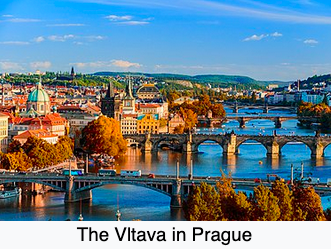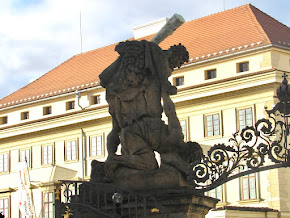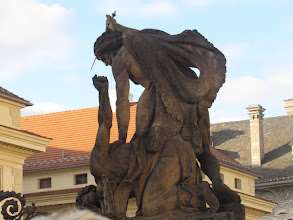Prague is one of the most beautiful cities in Europe. It is also one of the region's most important cities historically, geographically, culturally, and politically.
This center of the Habsburg monarchy (1282–1918) and Austria-Hungary Empire (1867–1918) played major roles in the Bohemian (1500s) and the Protestant Reformations (1550), the Thirty Years' War (), and in 20th-century history as the capital of Czechoslovakia and the post-war Communist era.
Today, it is a popular tourist destination that receives more than 8.5 million international visitors annually. In 2017, Prague was listed as the fifth most visited European city after London, Paris, Rome, and Istanbul.
Prague's beginnings
Prague was settled around the 9th century with a spacious marketplace on the banks of the Vltava River. Records dating back to 1100 AD indicate that a Saturday market was held there as well as large military gatherings. Thanks to these markets, the merchants of the area became rich. As a result, King Wenceslaus I of Bohemia bestowed the privileges of township and thus Prague as a city was formed. According to ancient records, Prague was well-protected with 13 gates and a huge moat.
By the mid-14th century Prague had grown into one of the most important political and economic centers in Central Europe. The development of trade and craftsmanship made it prosperous. When Bohemian King Charles IV became the Holy Roman Emperor in 1355, he made Prague his residence and founded the University of Prague in 1348.
Prague grew in size from its Old Town roots to the Lesser Town in 1357 thanks to the new bridge Charles IV began building over the Vltava River. In 1784, the four towns of Prague were incorporated into the Royal Capital City of Prague.
King Charles IV
Civilization has seen many kings; some are good and others range from mediocre to bad. Charles IV (1316-1378) was outstanding. A German king of Bohemia from 1346-1378 and Holy Roman emperor 1355-1378, he was one of the most learned and diplomatically skillful sovereigns
of his time because he bargained for power and influence through diplomacy (purchases, marriages, and inheritance) while others did so by war. As a result, Prague became the political, economic, cultural center of the Holy Roman Empire.
His crown and the prominence and influence of Bohemia on this region lasted until the 18th century.
The Holy Roman Empire developed in Central Europe in the Early Middle Ages under Charlemagne (800-814), the first Holy Roman Emperor
and king of the Franks (768-814) and Lombards (774-814). The Holy Roman
Empire lasted for almost a thousand years until Francis II abdicated
and dissolved the empire in 1806. This region had at one time been part
of the ancient Roman Empire. It was designated "holy" because it was consecrated
by Pope Leo III on Christmas 800.
Bohemia was a kingdom in the Holy Roman Empire and subsequently a part of the Habsburg monarchy and the Austria-Hungary Empire.
Prague Castle
Prague Castle was built in the 9th century. It has served as the seat of power for the kings of Bohemia, the Holy Roman emperors, and the presidents of Czechoslovakia. Today, it is the official residence and office of the president of the Czech Republic.
The castle also keeps the Bohemian Crown Jewels.
According to the Guinness Book of Records, Prague Castle is the largest ancient castle in the world, occupying an area of about 750,000 square feet. It remains a favorite for tourists attracting over 1.8 million visitors annually.
The castle builders were really into "clash of the Titans" themes with huge, hyper-testosterone men fighting it out as they are doing at the castle entrance. These expressions of power and might let all who entered know what they might encounter with the kings of Prague.
Bohemian Coat of Arms


Prague Castle's long history has afforded it a mix of architectural styles from different periods. It includes St. Vitus Cathedral (Gothic), Basilica of St. George (Romanesque), a monastery and several palaces, gardens and defense towers.
It also houses several museums, including the National Gallery collection of Bohemian baroque and mannerist art, exhibition dedicated to Czech history, Toy Museum and Rudolph II's picture gallery of Prague Castle. The Summer Shakespeare Festival (left) regularly takes place in the courtyard of Burgrave Palace.
St. Vitus Cathedral in all its amazing detail.



Each day at the Castle begins with the posting of the guard. The chief of the team leads the two guards and then leaves. The guards' duty last an hour before they are relieved by another two guards. The formality of it all dazzles tourists like us.

Old Town Prague
Old Town is a beautiful array of gigantic and colorful buildings set around a public square where people gather.


 A statue of Jan Hus (John Huss), He preached in the Bethleham Chapel 1402–1413, which further put Prague on the map of important major European cities.
A statue of Jan Hus (John Huss), He preached in the Bethleham Chapel 1402–1413, which further put Prague on the map of important major European cities.
I love these steeples with mini-steeples surrounding them. This is a different architectural form than I've seen before.
Astronomical Clock in Old Town
Shortly before the top of the hour, crowds gather to see the Astronomical Clock's celebrated 27 seconds. The "play" begins when a skeleton rings a bell as the Turk next to him shakes his head. A miser offers Death a purse full of money in a bid to pay his way out of dying. Meanwhile, the 12 traveling Apostles at the top of the clock take a peek out a window at the crowd below. The show ends as a golden rooster crows, and the huge bell at the top of the tower rings.
The clock was built by Master Hanuš in 1410. According to legend, the city councilors in an effort to maintain the uniqueness of this
wondrous machine, had the clockmaker blinded so that he could not create anything
similar ever again. Master Hanuš then allegedly broke the mechanism in
revenge, and it took a long time to make it work again. Whether or not the legend is true, the Astronomical Clock has been working flawlessly for centuries. It not only shows the date
and time (Central European, Babylonian and Sidereal), but it tracks
the position of the Sun and the Moon in the sky with various
astronomical details. Below are close-ups of the characters. The video shows the movement of the Apostles.
The skeleton rings the bell to begin the procession of Apostles. The Turk next to him represents the extravagance of Turkish culture.

Mozart
Near the Astronomical Clock is a remarkable carved door and a stunning building. The street to the left of the building leads to Mozart's house during a short time in Prague as well as Marie Curie's house.
 Mozart first came to Prague on January 11, 1787, to conduct a performance of The Marriage of Figaro. He then stayed for two
months. His primary residence was Thun Palace, which is now the British
Embassy, in Malá Strana on Thunovská Street. A letter thanking his
hosts is still in the possession of the embassy. However, musicologist and 18th century specialist on Prague Daniel E. Freeman disputes this claim.
Mozart first came to Prague on January 11, 1787, to conduct a performance of The Marriage of Figaro. He then stayed for two
months. His primary residence was Thun Palace, which is now the British
Embassy, in Malá Strana on Thunovská Street. A letter thanking his
hosts is still in the possession of the embassy. However, musicologist and 18th century specialist on Prague Daniel E. Freeman disputes this claim.
In January 1787 Mozart conducted a performance of The Marriage of Figaro at the Estates Theatre.
He stayed a second time from October to November 1787 near the Estates Theater. On this trip he conducted Don Giovanni.
He visited Strahov Monastery on November 16, 1787, and played the organ at the Church of the Ascension of the Virgin Mary.
Strahov Monastery -- St. Norbert Congregation

The first monastery was founded in 1143 by Jindřich Zdík, Bishop John of Prague, and Vladislaus II, Duke of Bohemia. The "White Brothers" eventually became an integral part of the spiritual and cultural history of the Czech lands. Strahov has also been a center of learning and culture throughout its history, and a spiritual center and pilgrimage destination. The Strahov Abbey Basilica also holds the relics of St. Norbert (1075-1134), which were transferred in 1627 from Magdeburg, Germany, where he was Archbishop. St. Norbert was canonized July 28, 1582, in Rome by Pope Gregory XIII.


Josefov -- Jewish Quarter
The
local Jewish community in Prague represents one of the oldest
continuously existing Jewish communities in the world. The synagogue
(lower right) is among the oldest living synagogues outside of the
Middle East. It is across the street from the small Jewish cemetery (lower left).
Josefov (also known as the Jewish Quarter) is the smallest area of Prague, and it is surrounded by the Old Town. Formerly the Jewish ghetto of Prague, the quarter is often represented by the flag of Prague's Jewish community, a yellow Star of David on a red field.
Jews settled in Prague around the 10th century. The first pogrom occurred in 1096 and resulted in concentrating the Jews within a walled ghetto. The ghetto became prosperous towards the end of the 16th century when the Jewish Mayor, Mordecai Maisel, became the Minister of Finance and a very wealthy man. His money helped develop the ghetto.
Joseph II, as Holy Roman Emperor, emancipated the Jews with the Toleration Edict in 1781. Two years before Jews were allowed to settle outside of the city. Only the Orthodox and poor Jews remained in Josefov.
Josefov
is reputed to have had over 18,000 inhabitants living in cramped,
angular, squinted buildings. The people were legally unable to bury
their dead outside the ghetto, so graves were built on top of each other
in the small cemetery.
Narrow streets like these were demolished between 1893 and 1913 as part of an initiative to model the city after Paris, which had gone through its own reconstruction to create the broad avenues and boulevards it has today. What remained in Josefov were six synagogues, the old cemetery (above left), and the Old Jewish Town Hall.
Cool Innovations
The Dancing House was completed in 1996. It was designed by Croatian-Czech architect Vlado Milunić and Canadian-American architect and designer, Frank Gehry. The deconstructivist house sits on the riverbank surrounded by imposing 18th and 19th-century Romanesque, Baroque, Gothic, and neo-Renaissance architecture.
The deconstructivist style emphasizes incongruity where buildings appear “deconstructed”, that is, lopsided, asymmetrical, and fragmented. Deconstructivist architecture breaks the rules of traditional architecture by eliminating harmony, clean shapes, and predictable textures.
Although the Dancing House was panned, it gradually won acceptance. A gold coin issued by the Czech National Bank in 2005 featured the Dancing House as part of a series called “Ten Centuries of Architecture.”
The Skoda is manufactured in the Czech Republic. You see a lot of these cars in France.
Sources
Dancing House -- https://www.atlasobscura.com/places/tancici-dum-the-dancing-house-of-prague
Strahov Monastery -- https://thirdeyetraveller.com/how-to-visit-strahov-library-prague/
https://www.strahovskyklaster.cz/en/norbertines
King Charles IV -- https://www.britannica.com/biography/Charles-IV-Holy-Roman-emperor
Charles Bridge -- https://en.wikipedia.org/wiki/Charles_Bridge
Prague Astronomical Clock -- https://www.praguego.com/attractions/astronomical-clock-orloj/
Mozart -- https://www.praguepost.com/culture/where-did-mozart-live-in-prague
https://www.praguepost.com/166-expats-in-cz/39974-mozart-in-prague
Old Town Prague -- https://en.wikipedia.org/wiki/Old_Town_(Prague)
Jewish Quarter (Josefov) -- https://en.wikipedia.org/wiki/Josefov
Dancing House -- https://www.masterclass.com/articles/dancing-house-architecture-explained#2Sy8iZI3LiLSiVqbZFhGmD
https://en.wikipedia.org/wiki/Dancing_House
Prague Castle -- https://en.wikipedia.org/wiki/Prague_Castle











































